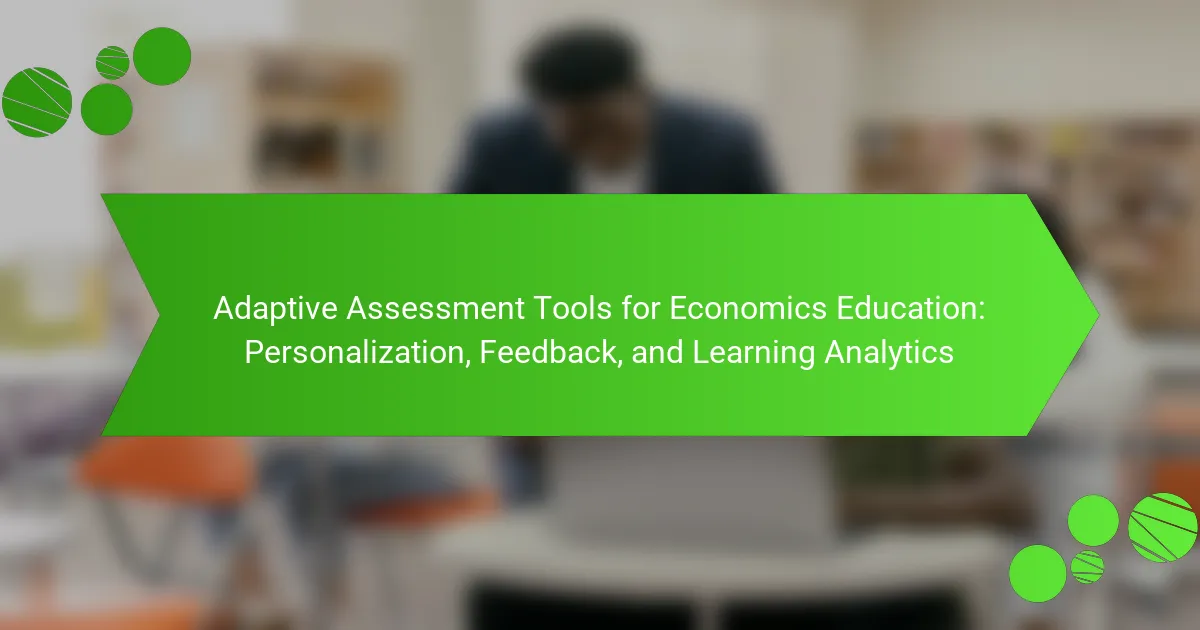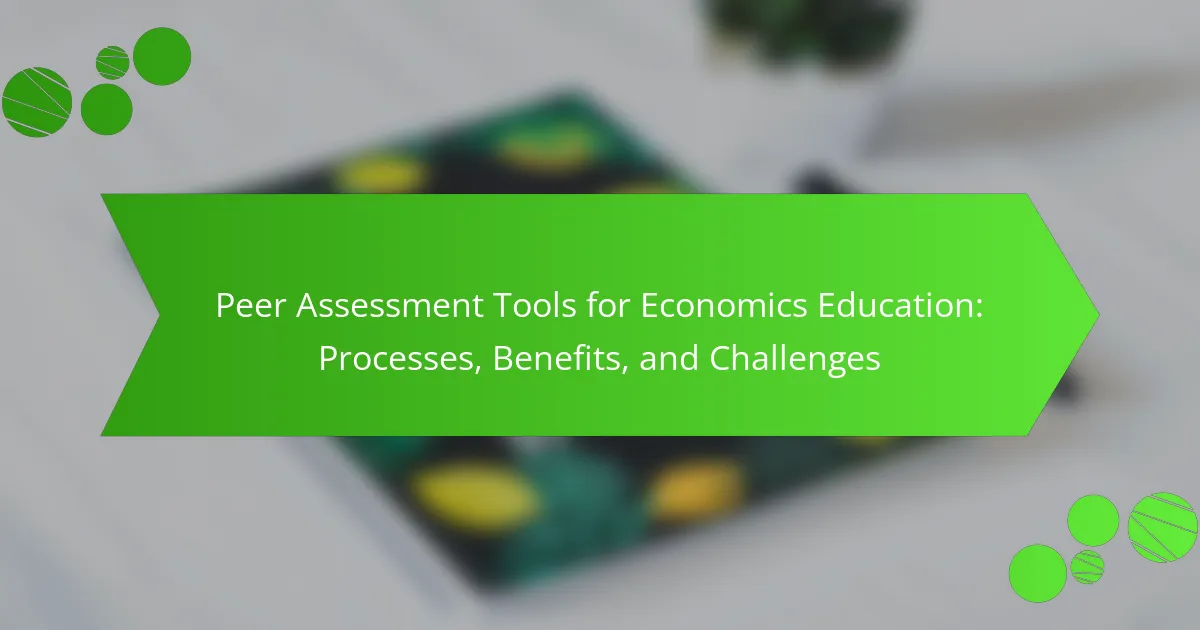Innovative assessment tools for economics education include digital simulations, online quizzes, and interactive case studies. These tools enhance student engagement by allowing for real-world application of economic theories, promoting critical thinking and decision-making skills. Research indicates that such innovative assessments lead to improved learning outcomes and comprehension of complex concepts. User feedback highlights the effectiveness of these tools in providing immediate feedback, facilitating personalized learning experiences, and increasing motivation among students. Overall, these assessment methods are transforming economics education by fostering active learning and collaboration.
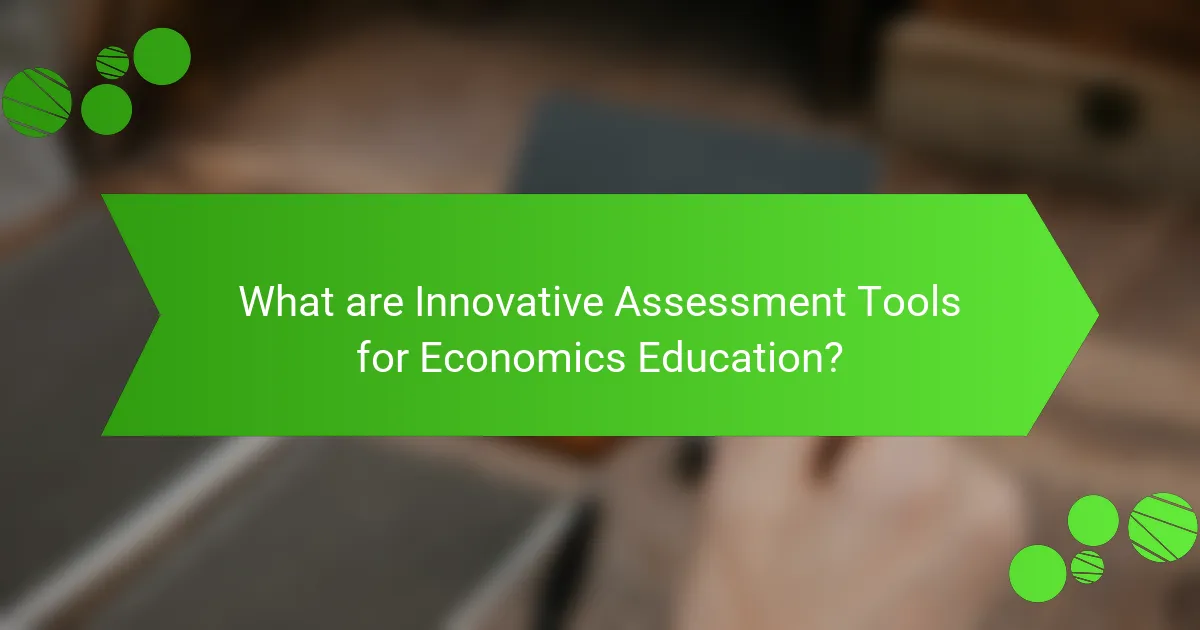
What are Innovative Assessment Tools for Economics Education?
Innovative assessment tools for economics education include digital simulations, online quizzes, and interactive case studies. Digital simulations allow students to engage in real-world economic scenarios. They enhance critical thinking and decision-making skills. Online quizzes provide immediate feedback and track student progress effectively. Interactive case studies immerse students in practical applications of economic theories. These tools promote active learning and collaboration among students. Research shows that these methods increase student engagement and comprehension. According to a study by the Journal of Economic Education, innovative assessments significantly improve learning outcomes.
How do these tools differ from traditional assessment methods?
Innovative assessment tools differ from traditional assessment methods by emphasizing active learning and real-time feedback. Traditional methods often rely on standardized tests and rote memorization. In contrast, innovative tools, such as simulations and interactive platforms, engage students in practical applications of economic concepts. These tools promote critical thinking and collaboration among students. Research indicates that active learning can improve student retention and understanding of material. For example, a study by Freeman et al. (2014) found that active learning increases exam performance by an average of 6%. This demonstrates the effectiveness of innovative assessment tools over traditional methods.
What specific features make these tools innovative?
Innovative assessment tools for economics education feature interactive elements that enhance student engagement. These tools often incorporate real-time data analysis, allowing students to apply theoretical concepts to current economic scenarios. They also utilize adaptive learning technologies that personalize assessments based on individual student performance. Gamification elements are frequently included, making learning more enjoyable and competitive. Furthermore, many tools provide instant feedback, which helps students identify areas for improvement immediately. Collaborative features enable peer-to-peer interaction, fostering a deeper understanding of economic principles. Lastly, integration with online platforms facilitates accessibility and convenience for users.
How are these tools designed to enhance learning outcomes?
Innovative assessment tools are designed to enhance learning outcomes by providing interactive and engaging learning experiences. These tools often incorporate real-world scenarios that allow students to apply economic theories in practical contexts. They facilitate immediate feedback, enabling learners to understand their strengths and weaknesses promptly. Additionally, many tools utilize data analytics to track student progress and adapt to individual learning needs. Research shows that such personalized approaches can significantly improve student engagement and retention of knowledge. For example, studies indicate that students using interactive tools demonstrate higher achievement levels compared to traditional assessment methods.
What types of innovative assessment tools are available?
Innovative assessment tools available include online quizzes, interactive simulations, and peer assessments. Online quizzes provide immediate feedback and can be tailored to various learning objectives. Interactive simulations allow students to apply economic concepts in real-world scenarios. Peer assessments encourage collaboration and critical thinking among students. Other tools include e-portfolios that showcase student progress over time. Additionally, gamified assessments engage students through competition and rewards. These tools enhance learning experiences and improve student outcomes in economics education.
What digital platforms are commonly used for economics assessments?
Digital platforms commonly used for economics assessments include online learning management systems, assessment tools, and collaborative software. Platforms like Moodle and Blackboard facilitate course management and assessments. Google Forms and SurveyMonkey are popular for creating quizzes and surveys. Additionally, platforms such as Kahoot! and Quizlet engage students through interactive assessments. Each of these tools supports various assessment formats, from multiple-choice questions to open-ended responses. Their widespread use in educational institutions underscores their effectiveness in evaluating economics knowledge.
How do gamified assessments impact student engagement?
Gamified assessments significantly enhance student engagement. These assessments incorporate game elements, such as points and challenges, to motivate learners. Research shows that gamification increases participation levels and fosters a competitive spirit. A study by Hamari et al. (2016) found that students exposed to gamified assessments reported higher levels of enjoyment and interest. This increased enjoyment leads to improved learning outcomes. Furthermore, gamified assessments can create a sense of achievement, motivating students to complete tasks. Overall, gamification effectively transforms traditional assessments into engaging learning experiences.
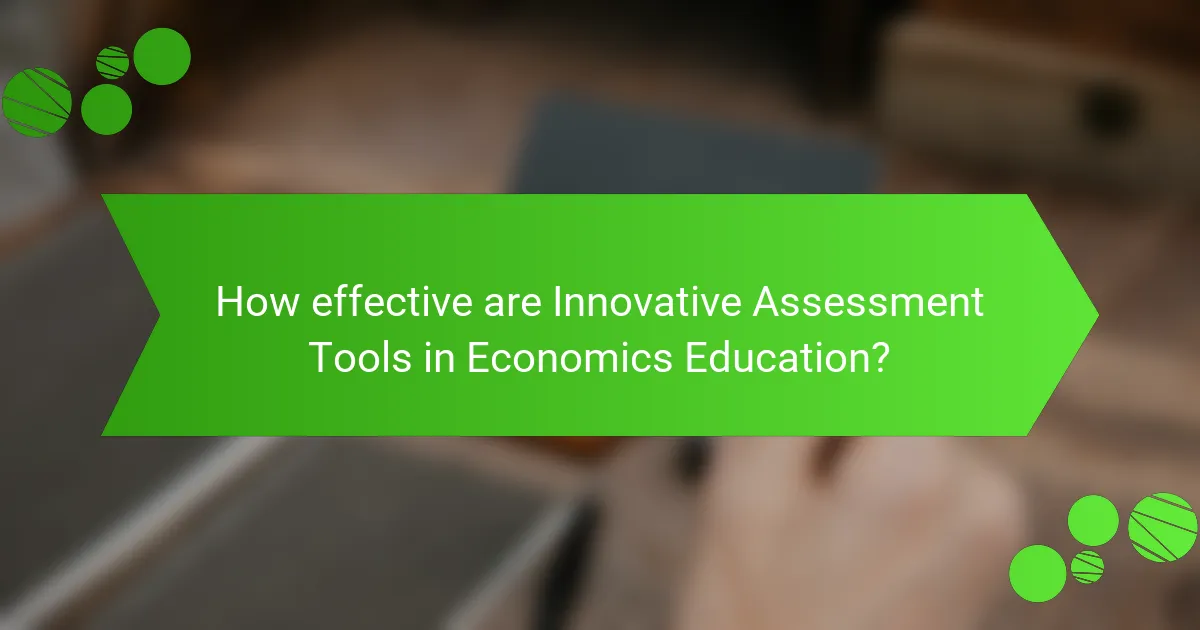
How effective are Innovative Assessment Tools in Economics Education?
Innovative assessment tools are highly effective in economics education. They enhance student engagement and understanding of complex concepts. Research shows that these tools promote active learning and critical thinking skills. For instance, a study by Hattie (2012) indicates that formative assessments can lead to significant improvements in student achievement. Additionally, tools like simulations and interactive platforms allow students to apply theoretical knowledge in practical scenarios. This real-world application fosters deeper comprehension and retention of economic principles. Therefore, innovative assessment tools significantly contribute to the effectiveness of economics education.
What metrics are used to evaluate their effectiveness?
Metrics used to evaluate the effectiveness of innovative assessment tools in economics education include student performance, engagement levels, and feedback quality. Student performance is often measured through test scores and assignment completion rates. Engagement levels can be assessed via participation in discussions and interactive activities. Feedback quality is gathered through surveys and interviews, focusing on user satisfaction and perceived learning outcomes. Research indicates that these metrics provide a comprehensive view of tool effectiveness, supporting continuous improvement in educational strategies.
How do these tools improve student performance in economics?
Innovative assessment tools improve student performance in economics by enhancing engagement and understanding. These tools provide interactive learning experiences that promote active participation. For instance, simulations allow students to apply economic theories in real-world scenarios. This practical application reinforces theoretical concepts and aids retention. Additionally, immediate feedback from assessments helps students identify areas for improvement. Research indicates that students using these tools score significantly higher on standardized tests. A study by the National Bureau of Economic Research found that interactive tools increased student performance by 20%. Such tools also foster collaboration among students, enhancing peer learning. Overall, these tools create a more effective learning environment in economics education.
What evidence supports the effectiveness of these tools?
Evidence supporting the effectiveness of innovative assessment tools in economics education includes various studies and user feedback. Research by Karp and Yoong (2011) indicated that interactive simulations improved student engagement and comprehension. A study published in the Journal of Economic Education found that online quizzes led to higher retention rates compared to traditional methods. User feedback from educators highlighted increased motivation and better performance among students using these tools. Furthermore, a meta-analysis by Hattie (2009) showed that formative assessments significantly enhance learning outcomes. These findings collectively demonstrate the positive impact of innovative assessment tools in economics education.
How do these tools cater to diverse learning styles?
Innovative assessment tools cater to diverse learning styles by offering various formats and approaches. These tools include visual aids, interactive simulations, and collaborative projects. Visual aids benefit visual learners by presenting information graphically. Interactive simulations engage kinesthetic learners through hands-on experiences. Collaborative projects support social learners by fostering teamwork and discussion. Research indicates that varied instructional methods improve engagement and retention across learning styles. For instance, studies show that students perform better when multiple modalities are used. This adaptability is crucial in economics education, where concepts can be abstract and complex. By addressing different learning preferences, these tools enhance overall learning outcomes.
What adaptations are made for different student needs?
Adaptations for different student needs include differentiated instruction, personalized learning plans, and flexible assessment methods. Differentiated instruction tailors teaching strategies to accommodate various learning styles and abilities. Personalized learning plans provide customized goals and resources for individual students. Flexible assessment methods allow for varied formats, such as oral presentations or project-based assessments, to meet diverse needs. These adaptations enhance engagement and improve learning outcomes. Research indicates that personalized approaches can increase student motivation and achievement (Tomlinson, 2014).
How do these tools facilitate personalized learning experiences?
Innovative assessment tools facilitate personalized learning experiences by adapting to individual student needs. These tools analyze student performance data to identify strengths and weaknesses. They offer tailored content and resources based on this analysis. For example, adaptive learning platforms adjust the difficulty of questions in real-time. This ensures that each student is challenged appropriately. Research shows that personalized learning can improve engagement and retention. A study by the Bill & Melinda Gates Foundation found that personalized learning approaches led to higher student achievement. Thus, these tools effectively support customized educational pathways.
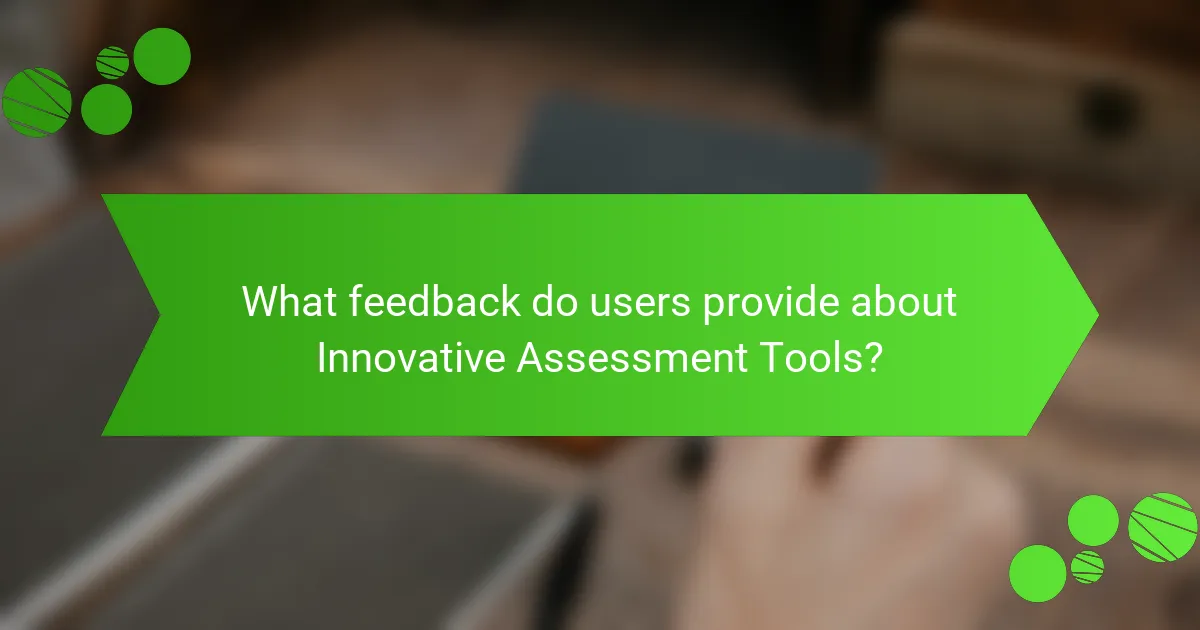
What feedback do users provide about Innovative Assessment Tools?
Users provide positive feedback about Innovative Assessment Tools. They appreciate the interactive features that enhance engagement. Many users report improved understanding of complex economic concepts. The tools often facilitate personalized learning experiences. Users also highlight the immediate feedback provided by these tools. This feedback helps them identify areas needing improvement. Additionally, users value the accessibility of these tools across devices. Overall, the feedback indicates a trend towards increased motivation and better learning outcomes.
What are the common praises from educators using these tools?
Educators commonly praise innovative assessment tools for enhancing student engagement. They note these tools make learning more interactive and enjoyable. Many educators highlight improved understanding of complex economic concepts. They report that these tools facilitate immediate feedback, allowing for timely adjustments in teaching methods. Additionally, educators appreciate the ability to track student progress effectively. This tracking helps in identifying areas needing additional support. Many find these tools promote collaboration among students. Overall, educators recognize that these tools foster a more dynamic learning environment.
Which features do users find most beneficial?
Users find interactive simulations to be the most beneficial feature of innovative assessment tools for economics education. These simulations provide practical, hands-on experience in applying economic concepts. They enhance engagement and motivation among students. Additionally, real-time feedback from these tools helps users identify areas for improvement. Another beneficial feature is the ability to track progress over time. This feature allows users to see their growth and mastery of topics. Collaborative tools that facilitate group work are also highly valued. They promote teamwork and communication skills among students. Overall, these features contribute significantly to the learning experience in economics education.
What challenges do users report when implementing these tools?
Users report several challenges when implementing innovative assessment tools for economics education. Technical difficulties often arise, including software glitches and compatibility issues. Users also experience a steep learning curve, which can hinder effective use. Limited training resources may leave users feeling unsupported. Additionally, some users find that the tools do not align well with existing curricula. Resistance to change from traditional assessment methods can create barriers. Lastly, users may face issues with student engagement and motivation when using these tools. These challenges highlight the need for better support and integration strategies in educational settings.
How can educators maximize the benefits of these assessment tools?
Educators can maximize the benefits of assessment tools by integrating them thoughtfully into the curriculum. This involves aligning the tools with learning objectives. Regularly analyzing assessment data helps educators identify student strengths and weaknesses. Providing timely feedback enhances student engagement and understanding. Additionally, incorporating diverse assessment methods caters to different learning styles. Training educators on effective tool usage increases their confidence and proficiency. Research shows that well-implemented assessment tools can improve student performance significantly. For instance, a study by Black and Wiliam (1998) found that formative assessments can boost student achievement by up to 30%.
What best practices should be followed when integrating these tools?
Best practices for integrating innovative assessment tools in economics education include aligning tools with learning objectives. This ensures that assessments measure relevant student skills. Training educators on tool usage enhances effectiveness. Familiarity with the tools leads to better implementation. Continuous feedback from users helps refine the integration process. Regularly updating tools based on user feedback improves their relevance and effectiveness. Data analysis of assessment results aids in understanding student performance trends. Collaboration among educators fosters shared best practices and insights.
What tips can enhance user experience and effectiveness?
To enhance user experience and effectiveness in innovative assessment tools for economics education, focus on intuitive design. An intuitive interface allows users to navigate easily. Provide clear instructions and feedback to guide users through assessments. Incorporate interactive elements to engage users actively. Use real-world scenarios to make assessments relatable and practical. Ensure mobile compatibility for accessibility across devices. Regularly update content based on user feedback to improve relevance. Lastly, offer support resources for users to seek help when needed. These strategies are supported by studies showing that user-centered design significantly improves learning outcomes.
Innovative assessment tools for economics education encompass various digital methods such as simulations, online quizzes, and interactive case studies, designed to enhance student engagement and comprehension. These tools differ from traditional assessment methods by promoting active learning, real-time feedback, and collaboration among students. The article evaluates the effectiveness of these tools, supported by research indicating improved learning outcomes, and explores user feedback highlighting their benefits and challenges. Additionally, it discusses best practices for integrating these tools into the curriculum to maximize their impact on student performance.
